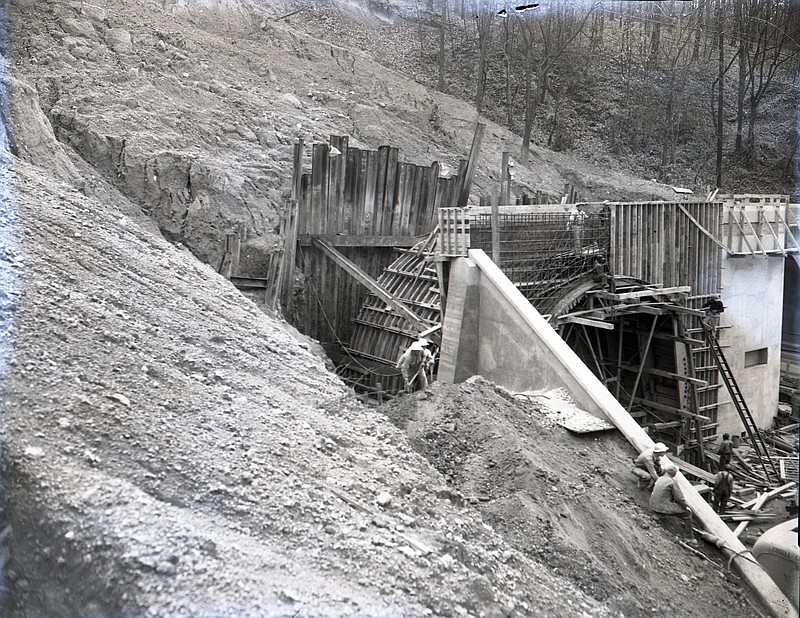(Editor's note: First of two parts)
Hamilton County Judge Seth M. Walker decided early in his administration to improve access to Chattanooga for residents living east and west of the city. The Stringer's Ridge Tunnel, providing an easier route of travel for residents of the valley and Signal Mountain, incurred delays but opened with great ceremony and acclaim in March 1910. Simultaneously, construction began on a tunnel through "Mission Ridge" that would bring Brainerd closer to Chattanooga for business, health care and sense of community. However, the Missionary Ridge project would take significantly longer and frequently frustrate county leaders.
In April 1910, the Chattanooga News reported that Judge Walker's road projects were progressing well. "The public roads of this county are in better condition now than they ever were ... . The opening of the tunnel through Stringer's Ridge has given the public a better route to the Walden's Ridge portion of the county ... . The work on the Missionary Ridge tunnel is progressing well. When it is completed, people living east of this ridge will have a much better route to and from Chattanooga. We should support the county authorities ... ."
Newspaper accounts reminded the judge and the Quarterly Court of consistent delays in drilling and completion of the tunnel. Less than six months after the Stringer's Ridge dedication, newspaper headlines seemed to spell doom: "Hole in the Hill Promises to Remain Simply a Hole -- Work on Mission Ridge Tunnel at Standstill over Business Differences. MUD CRUMBLES, TUMBLES, AND THINGS ARE IN A MESS. No 'Outcome' promised soon." Work had ceased on the tunnel as the "baffled contractors" searched for a solution and attempted to negotiate with the county for additional funds.
County Engineer W.L. Dodds and the contractor, H.F. McFarland, came to a standoff, refusing to meet further. "In the meantime, the people who have been looking forward for so long to the completion of the tunnel ... will have to resign themselves again to patience and waiting."
Construction began again one month later, only to stop in December 1910, when Dodds' inspection of the work resulted in his notice to McFarland that the "excavation was not up to the specifications of the contract." McFarland argued that the work was "all right and the matter stands," although he had dealt with "a bed of mud and soft crumbling earth which continually fell," covering up the tools and equipment. The extra supports required were, in McFarland's view, justification for increased funding, but county officials refused an override.
Brainerd residents were forced to watch the lack of progress, but the standstill was even more threatening for the "leading businessmen" who had purchased substantial acreage just east of the proposed tunnel for the creation of a new suburb. The business group had begun advertising plans for new homes in "Arcadia," meaning a place of rest and happiness, "up and out of the dust, fog and noise of the city." Investors expected the tunnel to be completed on schedule and streetcars and water mains to be extended into "Arcadia" shortly thereafter. They demanded a resolution.
Newly elected Judge Joe V. Williams, with approval from the Court, responded. County Attorney John H. Early was to notify McFarland that his contract would be canceled due to substandard work and progress if his workers did not return to the site immediately. Additionally, the county would seek damages, while other construction companies would be solicited for bidding. Fidelity and Deposit Company of Baltimore, the bonding agent for McFarland's company, telegraphed that it would be seeking legal counsel if the contract was broken. Early replied by telegram that Hamilton County had already engaged Watkins, Thompson and Watkins, and that only the highest quality work would be accepted on a tunnel to be used by its citizens. McFarland's contract was terminated.
One month later, on a Saturday in October 1911, the Missionary Ridge Tunnel Commission met with Engineer Dodds for the opening of the bids from three contractors: J.H. Bragg and Company, C.A. Riely and Ryan, and Smallwood and Company. Bids were based on materials plus labor, as requested by county government, in an attempt to keep the project moving, even when unexpected conditions occurred. Dodds was to handle the calculations, determine the lowest bid and then reconvene the committee within a week.
Commissioners left the meeting hopeful that work would resume shortly.
Linda Moss Mines is the Chattanooga and Hamilton County historian. For more on local history, visit Chattahistoricalassoc.org.
